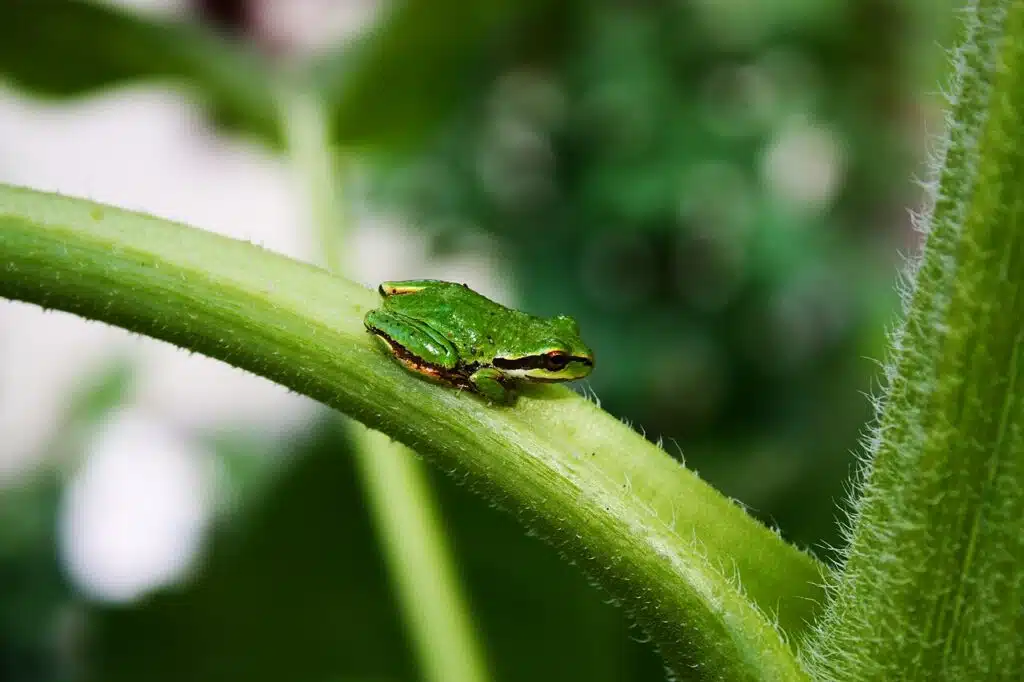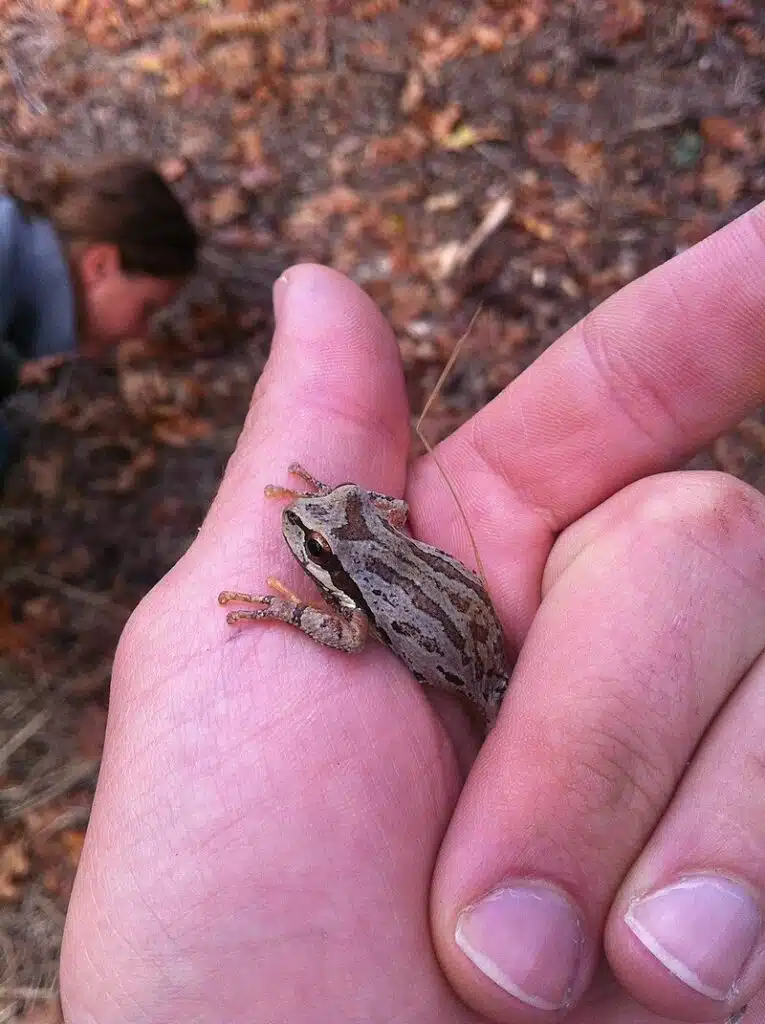Pacific tree frogs are interesting pets to watch and enjoy. Maybe you’ve recently found a frog in your back yard and want to give it a good home or you are wondering which tree frog is the right choice for you as a beginner amphibian pet owner.
Continue reading to find out more about how to care for the Pacific tree frog.
What are Pacific Tree Frogs?
The Pacific tree frog (Pseudacris Regilla) is a chorus frog that lives in a variety of habitats. They change color from greens to brown.
They are small frogs with a dark mask or eye stripe that can be seen running from the nostril through the eye to the shoulder. They also have a unique rounded toe pad on each of their digits.
They range from greens to tans, reds, and grays to black and can change colors over a few hours to a few weeks.

Natural Habitat
These frogs can be found in a host of habitats, breeding in freshwater, such as small ponds. They can be found in lakes, streams, and ponds in woodlands, pasture lands, back yard ponds, and grasslands.
Distribution
The Pacific Tree Frog can be found from California to Canada and British Columbia to Nevada. They are very common in Oregon and Washington. They were introduced to Alaska in the 1960’s.
Size
These are smaller tree frogs which grow up to two inches in length with males being slightly smaller than the female.
Lifespan
Pacific tree frogs breed from February through to August with tadpoles changing into froglets within three months of hatching.
A Pacific tree frog can live up to 7 years in the wild and are known to live up to 9 years in captivity with the right care.
Availability
These frogs are found across the United States in wooded areas and meadows, towns, and pastures. You can also purchase them from reputable amphibian breeders or pet shops.
| Pacific Tree Frog Quick Facts | |
|---|---|
Common Name | Pacific tree frog or Pacific chorus frog |
Scientific Name | Pseudacris regilla |
Size | 2 inches |
Lifespan | In the wild: up to 7 years In captivity: up to 9 years |
Tank Size | 12”x12”x18” |
Humidity | 50% – 80% |
Temperature | 65ºF – 85ºF |
Substrate | Coconut fiber |
Accessories | Water dish, vines, branches, plants |
Diet | Crickets, phoenix worms, waxworms, blue bottle fly spikes, dubia roaches |
Supplement | Calcium and multivitamin |
Are Pacific Tree Frogs Poisonous?
If you’ve found a Pacific tree frog and you want to home it, but you are scared of it being dangerous, then you will be pleased to know that they are not poisonous to humans or pets.
However, they do secrete a toxin on their body which can irritate eyes and nose if you don’t wash your hands thoroughly after touching the amphibian or cleaning out its enclosure.
Pets that grab the frog in their mouth may salivate excessively, which should pass. Rinse the pet’s mouth with fresh clean water.

Are Pacific Tree Frogs Good Pets?
The Pacific tree frog can live very happily for many years in the right enclosure with the right temperature and care. They are easy to care for and ideal for beginner pet owners to more experienced amphibian owners.
Remember these are not pets you will want to handle too often, but they can be interesting and enjoyable to watch as they climb around the enclosure in the evening and at night.
Pacific Tree Frog Setup
Tree frogs spend most of their time off the ground, in trees, hanging from vines and branches.
Of course, when you have them at home, they don’t have access to a tree, so you will want to provide ample sticks, branches, vines, and plants to keep them happy and healthy.
A vertical enclosure and habitat are essential to the overall health and happiness of your amphibian pet.
Enclosure
Your enclosure is where you will house your Pacific tree frogs. This needs to be tall to create the ultimate vertical habitat for your new pet.
As a rule of thumb, you can consider two enclosure sizes:
- 12”x12”x18” which is best suited for one to two Pacific tree frogs.
- 18”x18”x24” when you want to have between three and four tree frogs.
Lighting and Temperature
Even though your Pacific tree frog is nocturnal, it will need some light to mimic a day and night cycle when they live indoors. This means you need to provide some form of light for twelve hours per day.
The temperature inside the enclosure should be between 75ºF and 85ºF during daytime hours with a drop of between 65ºF and 75ºF during the night. It’s useful to have a nighttime bulb that will let you view your frog when it’s most active.
Use a digital thermometer to quickly and accurately monitor the enclosure temperatures to ensure the frog remains happy and comfortable.
Humidity
Pacific tree frogs enjoy a humidity of between 50% and 80%.
This can easily be achieved by using a good quality moisture holding substrate, adding a shallow water dish, and misting once or twice daily, if needed.
A digital hygrometer will enable you to monitor your enclosure humidity levels with ease.
Substrate
Pacific tree frogs do well with a natural substrate such as coconut fiber, which is excellent at holding moisture to aid with humidity levels.
Place up to three inches of substrate on the bottom of the enclosure, removing any poop daily.
The substrate should be removed and replaced monthly unless you are operating a bioactive enclosure set up.
Decoration
The decoration isn’t only about making the enclosure look visually appealing from your point of view, it’s essential to make your frog feel comfortable and safe.
Pacific tree frogs will hide in trees, covered by leaves and branches to feel safe and to get privacy while hiding from predators during the day.
Therefore, you will want to decorate your enclosure with plenty of artificial or live plants, branches, vines, and sticks to provide plenty of climbing and hiding areas for your amphibian pet.
Ensure you add a shallow water dish on the bottom of the enclosure.
You will find your frog may visit the water from time to time.
They soak the water through their skin, so ensure you only provide fresh mineral water without any toxins or chemicals.
The water also aids in boosting your humidity levels inside the enclosure.
Pacific Tree Frog Diet And Supplements
Food list
Tadpoles
- Algae
- Detritus (waste)
Adults
- Crickets
- Phoenix worms
- Waxworms
- Blue bottle fly spikes
- Dubia roaches
Supplements
Supplements are essential to keeping your Pacific tree frog healthy in a captive environment.
They need additional calcium and Vitamin D3 to ensure healthy bones and reduce the risk of metabolic bone disease.
Feeder insects should be dusted in calcium supplements up to three times weekly.
Multivitamin supplements are also very useful in ensuring your Pacific tree frog gets all the vitamins and minerals it needs to remain healthy and fit.
Feeding Guide
How much to feed
Pacific tree frogs can eat up to two to four small crickets per feeding.
When to feed
Remember your tree frog is nocturnal, which means it is most active at night. Therefore feed in the evenings, as the daytime light goes off and your frog starts to get a little more active.
How often to feed
How often you feed your Pacific tree frog is determined by whether its an adult or juvenile.
- Juveniles must be fed once a day
- Adults must be fed every alternate day
You may find your tree frog eats less in winter than it does in spring and summer, this is completely normal and not something to concern yourself with.
Ensure you remove any live food in the mornings and clean up any debris.
Gut loading
Gut loading is a common practice carried out by amphibian and reptile owners. It’s when you feed your feeder crickets a nutrient boosting meal before feeding them to your pet.
This includes vegetables, whole wheat bread, and grain. Allow the cricket to absorb the food for about 24 hours, ensuring it soaks up all the vitamins and minerals, and then feed to your pet.
Pacific Tree Frog Male or Female
Whether you have rescued a Pacific tree frog and brought it home or you have purchased one at your pet shop, you may be wondering if it’s male or female.
There are some telltale signs which can help you tell them apart, these include:
- Males tend to be smaller than females
- Males have a dark patch on their throats, which is their vocal sac
- Males have a rough patch on their arms and legs, which enable them to hold onto the female during mating. This is raised flesh, which can be found on each thumb. The thumb tends to be larger and thicker than the other fingers, this can be a sign that the frog is male.
- Males will croak at night without stopping. They do this to attract a female. Females use this call to identify which is the healthiest mate. If your frog is croaking throughout the night, you probably have a male on your hands and won’t want to keep the enclosure in your bedroom.
If you still cannot tell if your Pacific tree frog is male or female, then you may want to visit an amphibian vet who will be able to provide you with the answers you need.
can pacific tree frogs live with other, non poisonous, frogs; such as the whites tree frog?
This is a question that I can not answer. This is something I have not tried yet.
– From my understanding, different species create different toxins and waste that can be harmful to other species. Moreover, the water source (water bowl/dish) is usually shared which will spread the toxins.
– Each species have different needs of temperature, humidity, food. Therefore, you need to make sure both species have the same needs.
However, as far as I know, there are some people who successfully cohab to different species. Therefore, while cohabitation is not impossible, it should never be undertaken lightly. You need to do a lot of research
Hi! This is Little Creekwood Sanctuary. We are currently housing two frogs of rehabilitation, one of which is a pacific tree frog. This frog went along well with our northern leopard frogs but I do not recommend keeping two completely different species together. However, the pacific tree frog will get along with any other tree frog from its species or nearby frogs. These frogs are incredibly social and enjoy the company of other frogs. They do prefer cagemates of their own species. Also, they can produce a toxin in the form of goo on the underside of their belly and hind legs, which can irritate your eyes or nose if you do not wash your hands after handling these frogs. Also, the toxic can be harmful to toads and other frogs, but not any other species of tree frog.
Thank you, I hope this was helpful!
do i need a mesh screen on the top if I have a lot of plants in the enclosure?
Yes bro the frogs finna escape
Can you keep these tree frogs in a terrarium outside during the winter with average daytime temps of 32F-50F and nighttime lows of 20F-40F so they can hibernate like they do in the wild or must they be indoors under tightly controlled temps all year?